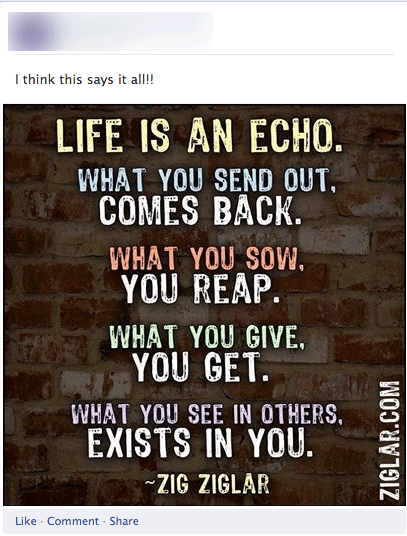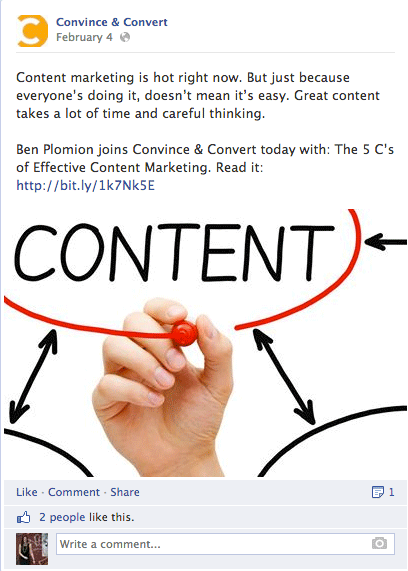By Brooke Ballard, {grow} Community Member
I’m going to unveil the secret to breaking through the noise on Facebook right here in this post. But for you to understand where I’m coming from, I need to tell you something about myself first. Here it is:
Excited about that? I wouldn’t blame you if you’re not. That kind of overused quote or meme tells you nothing about me, my beliefs or what kind of a person I am. There is no connection.
Let’s start again.

I believe in energy, in karma. My happiness is based on the happiness of those who support and surround me.
I hate that we can’t be a more open-minded society, but love that we have the freedom to decide what we want to believe and whom we want to love.
I can listen to Frank Sinatra and Deadmaus5 in one subway ride and feel exhilarated and invigorated by both.
At this point you’re probably leaning one way or another when it comes to trusting and liking me. By going beyond cliché information, I’ve helped you to get to know and understand me.
Cliché disclosures mean nothing, while facts, opinions and beliefs – or psychographics – mean everything to building trust and relationships. This is what I learned from my time at Penn State University, where I did an undergraduate honors thesis about successful connection strategies on social media.
Do You Trust Me? Do You Like Me?
The crux of my work looked at the Onion Theory (also known as the Social Penetration Theory). This theory states that we build relationships through different levels of communication, which range from shallow and cliché talk, to more personal and intimate conversations.
If we want to develop closeness with someone, we disclose personal information to them in hopes they will accept us and that our admission resonates with them.
Disclosures happens on four levels:
- Clichés
- Facts
- Opinions
- Feelings
When we start to move past the surface and the fluff of cliché-type conversation, we become vulnerable. By being vulnerable, we hope that the other person or persons will become vulnerable and open up to us, thus creating trust.
And it’s trust, as we all well know, which forms the foundation of any relationship.
Return on Conversation
My thesis posed this simple question: Can this type of deeper interaction and relationship building happen online (specifically on Facebook), between brands and consumers?
My research answered “yes.” (Details about the methodology can be found at the end of the post).
And even though it was somewhat early in the social game (2009-10), the really savvy brands had moved past asking their online communities what they were having for lunch, and were instead engaging by tugging on the proverbial emotional strings.
Demographics suddenly became “old school” and psychographics – or emotional marketing – emerged as the new goal of their conversations.
What’s your belief on …?
What do you think about …?
How does … make you feel?
Do you value …?
The return on this deeper conversation is amazing. Consumers are conditioned to open up about their preferences. As the conversation moves deeper, you can almost reach out and touch the trust forming between would-be clients and brands.
Not only can brands build trust, they can garner information they’ve previously had to pay for through focus groups or market research.
If you’re trying to use social media to gain sales, brand awareness, or loyalty, you must think more deeply about the conversations you’re having.
- If everything you share is cliché, your results will be cliché.
- If you only talk in facts, you may only receive factual information in return.
- If you tout opinions and ask for feelings, you may receive opinions, feelings and other psychographics from your community.
The Onion In Action
Let’s look at examples of each stage of disclosure (clichés, facts, opinions, feelings), and what happens when brands use them to garner conversation online. Brands not performing well have their names and logos blurred – we’re here to learn, not to criticize.
Clichés
This is a smaller page (nearly 1,000 fans) that posted a cliché-type post. There was no interaction (no one liked, shared, or commented on the post).
This is an exception to the results most brands see with cliché posts. I think the reason these posts work for Amy Porterfield is not because she has nearly 65,000 fans, but because she works hard to build trust with other deeper-disclosure posts (as shown below).
Facts
Jay Baer’s Convince and Convert page (nearly 8600 fans) shares mostly fact-type content. Educational posts work really well for teaching, but don’t do as much when it comes to building relationships and trust. Facts can solicit opinions from time-to-time, but rarely result in the deepest disclosure, feelings.
Opinions
I love this post from R & R Web Design LLC. Not only does the brand cleverly ask for specific opinions from its 3,000+ fan page followers here, but they also take the opportunity to better serve an existing client by using User Generated Content (UGC).
Amy’s Facebook Page is littered with opinion-seeking posts. I think this is part of the reason why she does so well, and why her cliché posts can also garner a lot of traction.
Feelings

How To Make The Onion Theory Work For Your Brand
Though the above posts may seem like small gestures in a vast online world, the brands truly building loyal communities use emotional marketing in their conversations.
My thesis and this post were focused on Facebook, but the theory can be used on any platform where conversation takes place.
My tips for emotional marketing success:
- Dump the clichés (memes and quotes don’t do anything to reinforce your brand messaging or build relationships/trust)
- Find other ways to let your brand’s personality shine
- Use facts to educate, but focus more on the opinions and feelings of your target audience
- Use the information and psychographics you glean from responses to better market to your consumers
- Remember to share your own opinions and feelings; transparency is key, or the relationship will be one-sided and won’t last
What are your thoughts about this research? Better yet, what are your feelings about it? : )

Notes on methodology:
I followed three NPOs (Special Olympics, Cystic Fibrosis Fibrosis Foundation, and Philabundance) for two weeks on Facebook and “labeled” every post as well as every comment (conversation) for depth of disclosures.
Qualitative and quantitative data were collected by reviewing the statistics collected on each nonprofit over two weeks and was then used to lend support to, or discredit, findings regarding the research objectives.
By conducting preliminary research on the Facebook pages of each nonprofit, the researcher was able to contrive several types of messages each nonprofit posted to their page. From there, a coding scheme was created to label each message into one of eight specific categories: News; Events: Past Events, Present Events, or Future Events; Fundraising or Soliciting Volunteers; Issues; Soliciting Stories or Narratives; or Miscellaneous. It was also decided that a message could only be coded as one type of message (i.e.: news, not news and event).
Secondly, the researcher explored the responses to messages sent out by each nonprofit to create a coding scheme for supporter responses. The responses were labeled into six specific categories: Accolades, Praise, and Thanks; References; Outreach or Support; Story or Narrative; General Response or Statement; or Miscellaneous. The process for coding was refined as the first week of coding began, and the researcher was able to make additions to include all of the types of categories needed to successfully label each message from the nonprofit, as well as each message from the supporters.
Additional information was collected, such as the number of entries the nonprofits posted to Facebook each day, the number of responses the messages received in a day, the number of responses to posts (or “sub posts”) each day, the number of “likes” each post and sub post received, and how many friends or fans each nonprofit had on each day of the coding week.








